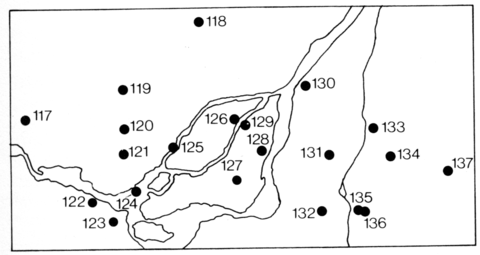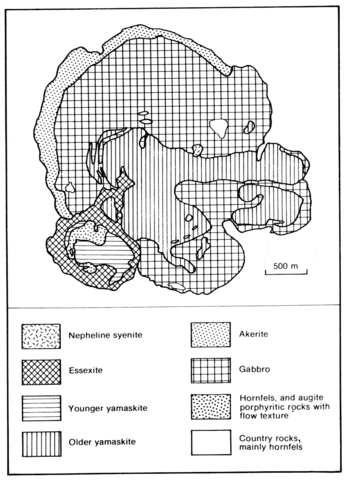stripes
The Mount Yamaska complex intrudes shales and sandstones of the Ordovician Sillery Formation which are metamorphosed for 60-450 m from the contact with the formation locally of complex breccias near the contact. The intrusion comprises an older series of yamaskite-gabbro-akerite, in which inward-dipping layering occurs, occupying 89% of the complex, and a younger body in the southwest of yamaskite-essexite. The older yamaskites vary widely in their modes; they comprise 20-58% titanaugite, 12-50% kaersutite, 0-15% plagioclase (An85-65), 8-19% opaques, and accessory apatite, sphene and occasional olivine (Fo80). Gabbro, the most abundant rock type at Yamaska, consists of plagioclase (An65-30), titanaugite, poikilitic kaersutite, occasional olivine (Fo80), biotite, opaques and accessories and a little quartz in the northwestern part of the intrusion; sodalite or analcime have been reported in the southeastern part, and nepheline occurs locally at contacts with the country rocks. The gabbro grades through a transition zone 3-15 m wide into akerite (augite monzonite) which forms a border zone to the west, north and northeast. The younger series includes ultramafic yamaskite and mafic and felsic essexites. The younger yamaskites are similar to the kaersutite-rich older yamaskites, but the essexites differ from the gabbros in containing 5-10% nepheline and up to 15% alkali feldspar. Within the younger series is a mass of hornfels which is cut by an augite-phyric porphyry. The youngest igneous phase is a small plug of nepheline syenite and nepheline syenite dykes. Other dykes of yamaskite, gabbro, essexite, diorite, bostonite and syenite aplite occur within the complex and the hornfels collar. Rock and mineral analyses are given by Gandhi (1970).
CURRIE, K.L. 1976a. The alkaline rocks of Canada. Bulletin, Geological Survey of Canada, 239: 1-228.
EBY, G.N. 1984b. Geochronology of the Monteregian Hills alkaline igneous province, Quebec. Geology, 12: 468-70.
GANDHI, S.S. 1970. Petrology of the Monteregian intrusions of Mount Yamaska, Quebec. Canadian Mineralogist, 10: 452-84.
YOUNG, G.A. 1906. The geology and petrography of Mount Yamaska. Annual Report, Geological Survey of Canada, 16,H: 1-43.


